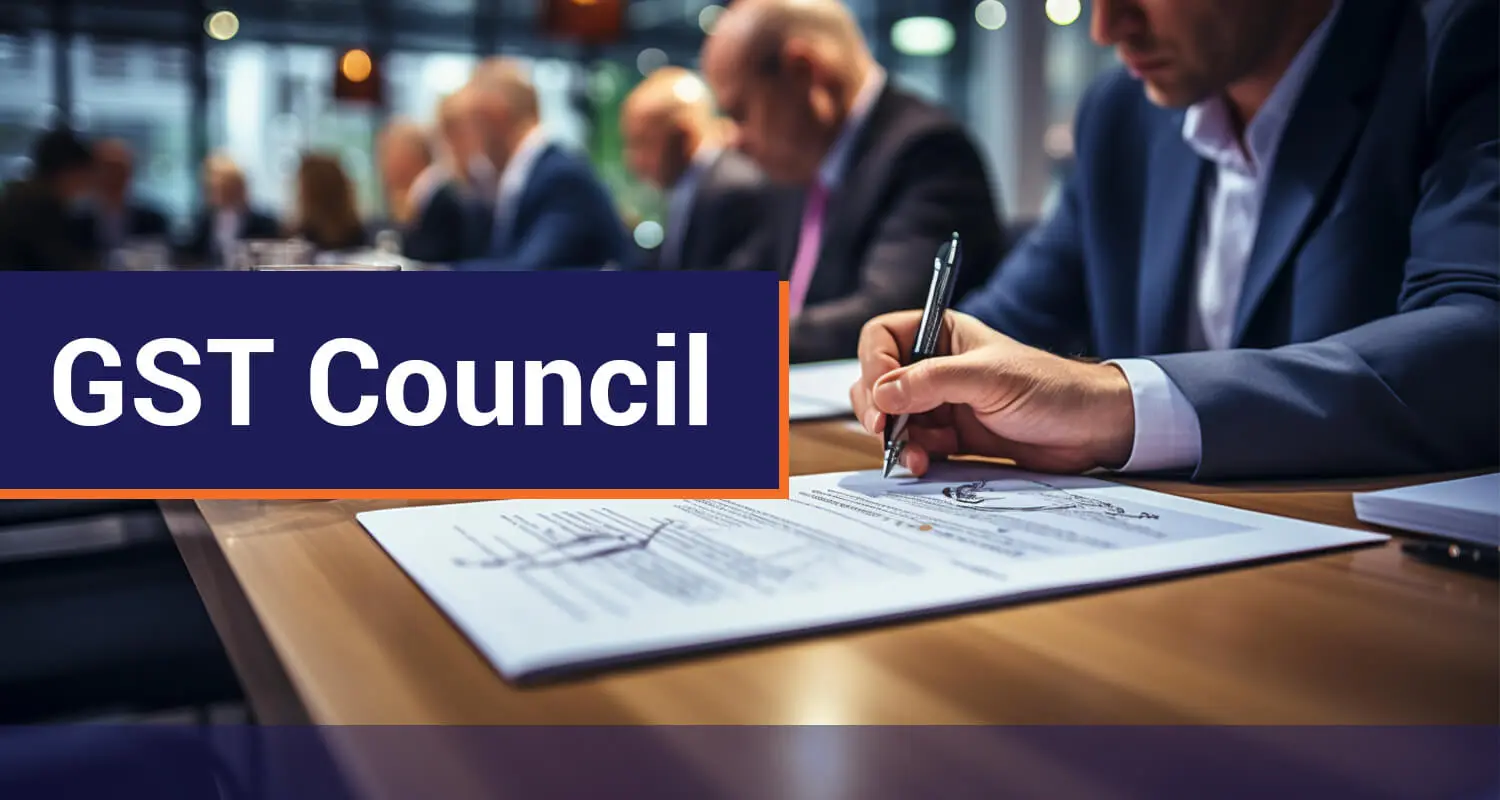GST Composition Scheme: Meaning, Benefits & Turn Over Limit

While small businesses are the cornerstone of India's economic landscape, navigating the complexities of tax compliance can pose a significant challenge. Recognizing this hurdle, the Goods and Services Tax (GST) regime offers a simplified solution through the GST Composition Scheme. This article explains the details of this scheme, providing insights into its definition, features, benefits, and operational mechanics.
What is the GST Composition Scheme?
The composition scheme under GST is a voluntary option available to eligible taxpayers with an annual turnover below a specified limit. Under this scheme, businesses pay a fixed tax rate on their turnover instead of the regular GST rates applicable on individual sales and purchases. This simplified approach reduces compliance burden and administrative costs for small businesses.
The composition scheme in GST is defined as an alternative method of tax levy designed specifically for small taxpayers. It allows them to pay a pre-determined percentage of their turnover as GST liability instead of calculating tax on individual transactions.
Who is Eligible for the Composition Scheme in GST?
The GST composition scheme is designed to benefit small businesses in India. Here's a breakdown of the eligibility:
GST Composition Scheme Turnover Limit:
- Turnover Limits: Your business turnover in the previous year must be up to Rs. 1.5 crore for manufacturers and traders, or up to Rs. 50 lakh for service providers (special category states have a higher limit of Rs. 75 lakh).
- PAN Turnover: The scheme considers the combined turnover of all businesses registered under your PAN card. This means if you have other businesses, their turnover is added to calculate your eligibility.
Features of GST Composition Scheme
Simplified Tax Compliance:- Reduced Record-keeping: Under the regular GST scheme, businesses need to maintain detailed records of every sale and purchase, including the applicable tax rates. The composition scheme eliminates this requirement, significantly reducing the time and effort required for record-keeping.
- No Complex Calculations: Calculating tax for each individual transaction under the regular scheme can be cumbersome, especially for businesses with a high volume of sales and purchases. The composition scheme simplifies this process by applying a fixed tax rate to the total turnover, eliminating the need for intricate tax calculations.
- Predictable Tax Liability: Instead of grappling with varying tax rates based on different product categories, businesses under the composition scheme pay a pre-determined percentage of their overall turnover as GST. This predictability simplifies budgeting and cash flow management.
- Lower Tax Rates: In many cases, the fixed tax rates under the composition scheme are lower than the combined rates applicable under the regular scheme. This can allow businesses for potential tax savings.
- Fewer Returns: Composition taxpayers file only one quarterly return (CMP-08) and one annual return (GSTR-9A). This is a significant reduction compared to the multiple returns (GSTR-1, GSTR-2, GSTR-3B, and GSTR-9) required under the regular scheme, minimizing the administrative burden associated with GST compliance.
- Simpler Filing Process: The composition scheme returns are generally shorter and less complex compared to those under the regular scheme, further streamlining the filing process.
- Limited Cost Savings: Businesses under the composition scheme can't use the GST they pay on purchases to reduce their tax liability on sales. They can't offset taxes paid on purchases against taxes owed on sales. This might affect cost savings, especially for businesses buying a lot from suppliers under the regular GST scheme.
Sapna aapka. Business Loan Humara.
Apply NowBenefits of GST Composition Scheme
Ease of Operation:- Reduced Complexity: The composition scheme streamlines GST compliance by eliminating the need for intricate calculations and detailed record-keeping of individual sales and purchases. This allows small businesses to concentrate on resources and on core business activities rather than getting involved in complex tax procedures.
- Simpler Filing: Instead of the multiple returns required under the regular GST scheme, composition taxpayers file only one quarterly return and one annual return. Thus making it easier for small businesses to manage their GST obligations.
- Straightforward Calculations: The fixed tax rate applied to turnover simplifies tax calculations. Businesses know exactly what their GST liability will be, eliminating the need to calculate tax on each transaction with varying rates.
- Less Time Spent on Compliance: With simplified procedures and fewer returns, businesses under the composition scheme spend less time and resources on GST compliance. This translates to cost savings in terms of accounting and bookkeeping expenses.
- Lower Professional Fees: The reduced complexity of the scheme may also lead to lower professional fees for accounting and tax services compared to the regular GST regime.
- Predictable Tax Liability: Knowing the fixed tax rate beforehand allows businesses to accurately forecast their GST liability, facilitating better cash flow management. This can be crucial for small businesses that often operate with limited financial resources.
- Faster Tax Payment Cycle: The quarterly filing system under the composition scheme allows for quicker GST payment compared to the monthly filing required under the regular scheme. This can potentially improve cash flow by reducing the amount of tax outstanding at any given time.
- Less Detailed Records: Unlike the regular scheme, which demands detailed records of every sale and purchase with applicable tax rates, the composition scheme requires less comprehensive record-keeping. This minimizes the administrative burden associated with maintaining extensive financial records.
Types of GST Composition Scheme
There are different composition schemes based on the type of business activity:
1. Manufacturers and Traders:- Tax Rate: The tax rate for manufacturers and traders under the composition scheme typically ranges from 1% to 6% of their total turnover. This rate is further divided equally between Central GST (CGST) and State GST (SGST).
- 1% Rate: This rate generally applies to most manufacturers and traders eligible for the scheme.
- 2% Rate: Certain specific types of manufacturers may be subject to a 2% tax rate under the composition scheme.
- Tax Rate: Restaurants not serving alcoholic beverages typically have a fixed tax rate of 5% of their total turnover under the composition scheme. This rate is also split equally between CGST and SGST.
- Turnover Limits: It's crucial to remember that the eligibility for the composition scheme is based on the annual turnover of the business. The current limit for opting into this scheme is Rs. 1.5 crore.
- Specific Exclusions: Some businesses are not eligible for the composition scheme on GST, such as manufacturers of ice cream, pan masala, or tobacco products, businesses making inter-state supplies, and those supplying goods through e-commerce operators.
Who Can't Apply for the Composition Scheme?
The GST composition scheme isn't for everyone. Here are some businesses that are excluded:
- Selling Through E-commerce Platforms: If you sell goods through an online platform that collects tax at source (TCS), you're not eligible.
- Non-Residents & Occasional Sellers: This scheme isn't for businesses that are not permanently established in India (non-resident) or those making occasional taxable supplies (casual taxable person).
- Certain Food & Tobacco Products: Manufacturers of ice cream (without cocoa) and pan masala/tobacco products and substitutes cannot participate.
- Unregistered Suppliers: Businesses that have purchased goods from unregistered suppliers are ineligible.
- Exempt Goods & Services: If your business supplies goods or services exempt under the GST Act, you can't join the scheme.
- Combined Goods & Services: Businesses supplying both goods and services are not covered under the composition scheme.
Who can avail of the GST composition scheme?
If your company's annual turnover falls within the specified range, you can apply for the GST composition scheme. However you need to remember that the limits set forth by the GST composition scheme considers the turnover of all the businesses registered under a particular PAN. Simply put, small manufacturers, traders, and service providers can avail of the composite scheme.
Things to Consider Before Opting for the GST Composition Scheme
While the composition scheme offers simplified tax filing, there are a few limitations to keep in mind:
- No Input Tax Credit (ITC): Businesses cannot claim credit for taxes paid on purchases (like materials or supplies) against the tax they collect from customers. This can increase your overall tax burden, especially if you buy from businesses under the regular GST scheme.
- Limited Reach: You can't make interstate sales (across state borders) under this scheme. This might restrict your customer base and hinder growth. Additionally, you can't sell goods through e-commerce platforms, which limits your online reach.
- No Tax Collection: You cannot collect GST from your customers since you pay a fixed rate on your total sales. This might be a disadvantage if your target market consists primarily of regular GST taxpayers who could benefit from claiming ITC on the tax they pay you.
In short, the composition scheme is a good fit for small businesses with local operations and limited purchases from regular GST payers. Consider these GST composition scheme rules to see if it aligns with your business model.
What are the composition scheme under GST tax rates?
When you register for GST composition, a fixed tax rate applies to your business turnover:
- For goods manufacturers and traders: 1% GST (0.5% CGST + 0.5% SGST)
- For restaurants not serving alcohol: 5% GST (2.5% CGST + 2.5% SGST)
- For service providers: 6% GST (3% CGST + 3% SGST)
How Easy is Filing GST Returns under the Composition Scheme?
- Regular GST filing can be a complex process. But the composition scheme offers a breath of fresh air! Here's why:
- Minimal Paperwork: Forget filing multiple returns every month! Under the scheme, you only need to file one return every quarter (GSTR-4) and one annual return (GSTR-9A).
- Simple Deadlines: GSTR-4 filings are due by the 18th of the month following each quarter, giving you ample time to manage your paperwork.
How does it Works?
The process of availing the GST composition scheme involves the following steps:
-
Eligibility Check: Businesses need to ensure their annual turnover falls within the specified limit (currently Rs. 1.5 crore).
-
Opting for the Scheme: An application needs to be filed electronically before the commencement of the financial year.
-
Quarterly Returns: Quarterly returns (CMP-08) must be filed within the specified deadlines.
-
Annual Return: One annual return (GSTR-9A) needs to be filed after the financial year.
-
Tax Payment: Tax liability based on the fixed rate and turnover needs to be paid within the prescribed due dates.
Conclusion
The GST composition scheme offers a valuable option for small businesses in India. By simplifying tax compliance and reducing administrative burdens, it encourages their participation in the formal economy. However, it is important to carefully analyze their eligibility and the implications of limited input tax credit before opting for this scheme.
FAQs
Q1. What is the GST composition scheme?Ans. The GST composition scheme is a simplified way for small businesses with annual turnover below Rs. 1.5 crore to pay GST. Instead of calculating tax on each sale and purchase, they pay a fixed percentage of their total turnover as GST.
Q2. Who can opt for the composition scheme?Ans. Businesses that primarily manufacture or trade goods, restaurants not serving alcohol, and certain service providers with a turnover below Rs. 1.5 crore can choose this scheme. Inter-state suppliers and businesses involved in specific activities are not eligible.
Q3. What are the drawbacks of the composition scheme?- No input tax credit: Businesses cannot claim tax paid on purchases, potentially impacting cost savings.
- Fixed tax rates may not always be advantageous: Depending on profit margins, the fixed rate might be higher than the combined tax rate under the regular scheme.
Ans. Composition taxpayers need to file only one quarterly return (CMP-08) and one annual return (GSTR-9A).
Sapna aapka. Business Loan Humara.
Apply NowDisclaimer: The information contained in this post is for general information purposes only. IIFL Finance Limited (including its associates and affiliates) ("the Company") assumes no liability or responsibility for any errors or omissions in the contents of this post and under no circumstances shall the Company be liable for any damage, loss, injury or disappointment etc. suffered by any reader. All information in this post is provided "as is", with no guarantee of completeness, accuracy, timeliness or of the results etc. obtained from the use of this information, and without warranty of any kind, express or implied, including, but not limited to warranties of performance, merchantability and fitness for a particular purpose. Given the changing nature of laws, rules and regulations, there may be delays, omissions or inaccuracies in the information contained in this post. The information on this post is provided with the understanding that the Company is not herein engaged in rendering legal, accounting, tax, or other professional advice and services. As such, it should not be used as a substitute for consultation with professional accounting, tax, legal or other competent advisers. This post may contain views and opinions which are those of the authors and do not necessarily reflect the official policy or position of any other agency or organization. This post may also contain links to external websites that are not provided or maintained by or in any way affiliated with the Company and the Company does not guarantee the accuracy, relevance, timeliness, or completeness of any information on these external websites. Any/ all (Gold/ Personal/ Business) loan product specifications and information that maybe stated in this post are subject to change from time to time, readers are advised to reach out to the Company for current specifications of the said (Gold/ Personal/ Business) loan.



